Rod Miller's Blog, page 29
July 22, 2016
I’m trending, I’ve gone viral, and I broke the Internet.

Well, not really. But since those phrases are tossed around like rice at a wedding, I figure they may as well apply to me as the next guy. Besides that, they have no objective meaning that I’ve been able to discern or ever seen quantified. Which means, in the end, they are nothing more than what’s long been known in the advertising business as “puffery.” Or, to abbreviate the term I am more likely to voice, BS.Such vague and nebulous (and meaningless) superlatives are easily assigned to anyone or anything at any time by anyone. Some people will be fooled by them. Most will ignore them. And rightly so. Even extreme claims with some factual basis can be meaningless. For instance, in the book world, “best seller” and other such rankings are often accurate but still worthless. Years ago, in the days when Amazon ran a short-lived program of selling short stories online, I had a couple of stories that, for several weeks, were listed as either the top or number-two selling Western stories. But they never sold enough copies to accumulate enough royalties to result in a paycheck—and the threshold was pretty low, as I recall.Still and all, I guess it gives me the right to claim being a “Best-Selling Author!” After all, I am the guy who broke the Internet. Not to mention “trending” and having gone “viral.”
Published on July 22, 2016 11:14
July 14, 2016
Lies They Tell Writers Part 30: Write the way people talk.

Sometimes, some writing teachers teach people to mimic the way people talk when writing dialogue. The truth is, it doesn’t work. Our last installment of “Lies” addressed trite words we use in conversation (“incredible,” “awesome,” “amazing”) that are mostly useless on the page. Then there are those other little clichés that creep into and out of our mouths. Just for fun, get yourself a notebook and make a mark every time you hear someone start a sentence with “So.” It’s an affectation of epidemic proportions these days. Imagine what your page would look like if every other or third or fourth line of dialogue started like so: “So.”“So,”“So—“So;”While you’ve got that notebook in hand, keep track of the abuse of “like.” You know what I mean: “He’s, like,” “I’m, like,” “it was, like,” and the like. Likewise, “I mean.” Sometimes writers try to mimic the speech of young people (where most of these language trends start) in an effort to sound “cool” (another word rendered useless to the point you dare not use it, even correctly). It doesn’t work. It’s usually overdone. It sounds phony. It sounds like the author is trying too hard. And it doesn’t fool anyone. The same holds true when unknowing writers try to mimic the way cowboys talk. Or doctors. Or sailors. Or the lingo of most any other assemblage of folks with a language partly their own, including dialects. As the late, great Elmer Kelton used to say about writing dialect and slang: a little goes a long way. Fear not. You can write good dialogue. You can create conversations that are realistic, informative, reveal your characters, advance the story, and entertain. It’s not a matter of simply recording the words people use. It requires hearing—listening beyond the affectations and clichés and hearingthe characteristics of conversation that define the speakers and capture their lingo. Then, rather than filling pages with the phony-baloney twaddle a recording device hears, you can write dialogue that sounds like people talking rather than writing the way we really talk. Your readers will thank you.So, uh, I mean, give it a try. It’ll be, like, um, awesome, y’know.
Published on July 14, 2016 05:27
July 2, 2016
Lies They Tell Writers, Part 29: To learn to write dialogue, listen to people talk.
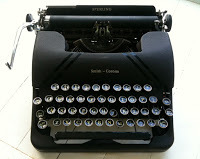
Writing dialogue is one of the most difficult things writers do. That must be the case, because so much of it is so awful. Think of all the times you’ve looked wide-eyed at a page or the silver screen and thought, no one talks like that!To cure this ill, many writing instructors encourage students to eavesdrop on conversations and mimic that kind of speech.Don’t do it.Writing the way people really talk just might be worse than the stiff, stilted stuff that sometimes masquerades as dialog.Think about it. If you write the way people talk, your page will be peppered with “um” and “uh” and “I mean” and “y’know” and other fillers that are as natural as breathing to most people. Then there are the useless, overused words we use. Decades ago, when I started paying attention to such things, some—many—people used “incredible” to describe anything and everything that struck their fancy. While the word is still overused, “awesome” eventually replaced it in the mouths of many. Nowadays, “amazing” has clawed its way to the top of the hackneyed heap. (Never mind the fact that the way we use those words has little to do with their actual meanings.)Imagine your characters repeatedly using “amazing” to describe things—almost everything, really. Readers would never know if the object of their amazement was, say, delicious (or tasty) beautiful (or easy on the eyes) or smooth-gaited or soft or hard or warm or fast or thought-provoking or melodious or whatever. The generic descriptions people use in actual conversation—like “amazing” and “awesome”—make for dull, meaningless dialogue. The trick isn’t to write like people talk. It’s to write dialogue that sounds like people talking—it’s more vivid, more descriptive, more “real” than the real thing. But it sounds like the real thing. Stay tuned for a future installment on writing dialogue. It will be amazing.
Published on July 02, 2016 07:49
June 27, 2016
“Goodbye, Old Paint…
…I’m leavin’ Cheyenne.”Truth be told, unlike that classic cowboy song lyric, I’ve already left Cheyenne. We were there last week for the annual Western Writers of America convention. As usual, the WWA convention was a good time. I saw lots of fellow writers who’ve become friends over the years, and I met some who likely will become friends. I sat in some interesting panel discussions and presentations and visited some interesting historic sites in the area. And, to repeat myself, my novel
Rawhide Robinson Rides the Tabby Trail: TheTrue Tale of a Wild West CATastrophe
received a handsome certificate as a Finalist for the Spur Award for Best Western Juvenile Fiction, a book suitable for readers from junior high age to geriatric.
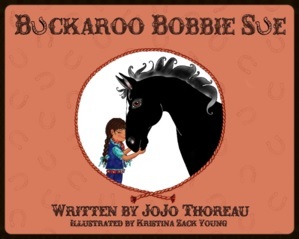
Without a doubt, the highlight of the convention was the acceptance of a Spur Award for Best Western Storyteller by young author JoJo Thoreau, author of the illustrated children’s book Buckaroo Bobbie Sue. Calling her young is not an exaggeration—JoJo is nine years old.Which is certainly a novelty.But her book and her Spur Award are no novelty. She’s an honest-to-goodness writer and Buckaroo Bobbie Sue is an honest–to-goodness book. It‘s the colorfully illustrated rhyming story of a young girl’s wish to, as we say in the cowboy trade, “make a hand,” and her rise to heroics at the right minute. I played a small role in the making of the book and am pleased as punch that JoJo (who’s too young to know better) trusted me help out.Leaving Cheyenne wasn’t easy, but at least as we rode out of town “leading Old Dan” we left with saddlebags full of fine memories—including meeting in person the budding—but already accomplished—author JoJo Thoreau.
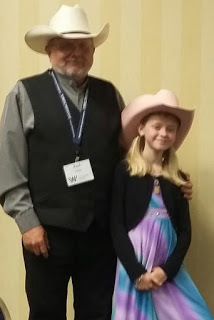

Without a doubt, the highlight of the convention was the acceptance of a Spur Award for Best Western Storyteller by young author JoJo Thoreau, author of the illustrated children’s book Buckaroo Bobbie Sue. Calling her young is not an exaggeration—JoJo is nine years old.Which is certainly a novelty.But her book and her Spur Award are no novelty. She’s an honest-to-goodness writer and Buckaroo Bobbie Sue is an honest–to-goodness book. It‘s the colorfully illustrated rhyming story of a young girl’s wish to, as we say in the cowboy trade, “make a hand,” and her rise to heroics at the right minute. I played a small role in the making of the book and am pleased as punch that JoJo (who’s too young to know better) trusted me help out.Leaving Cheyenne wasn’t easy, but at least as we rode out of town “leading Old Dan” we left with saddlebags full of fine memories—including meeting in person the budding—but already accomplished—author JoJo Thoreau.

Published on June 27, 2016 16:14
June 15, 2016
Another campfire tale from Rawhide Robinson.
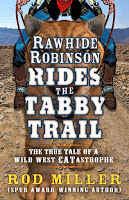
Rawhide Robinson, the ordinary cowboy who often finds himself in extraordinary situations, has news. This time—unlike his usual campfire anecdotes—it’s true from beginning to end. Western Fictioneers, an international organization of professional authors who write about the Old West, recently announced the winners of their 2016 Peacemaker Awards. You may recall that earlier, I wrote that Rawhide Robinson Rides the Tabby Trail: The True Tale of a Wild West CATastrophe —was named a Finalist for Best Western Novel for Young Adults, and I promised an update if there were any developments. Well, it won.That sentence probably deserves an exclamation point, but I try to follow Elmore Leonard’s advice and limit myself to two or three for every 100,000 words of prose. But don’t let the lack of a punctuation mark fool you—I am surprised and stunned and happy and honored to have a book I created win an award named after Samuel Colt’s most famous creation. Rawhide Robinson Rides the Tabby Trail: The True Tale of a Wild West CATastrophe is available in hardcover and e-book and will make enjoyable reading for book lovers from junior high school to geriatric age. Finally, since cat videos are so popular on the Internet, I’ve posted the little promotional video for the book. Click on it and take a look. (Spoiler alert: it does, in fact, include cats.)
Published on June 15, 2016 15:30
June 12, 2016
New news (sort of) about the Bear River Massacre.
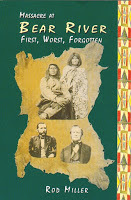
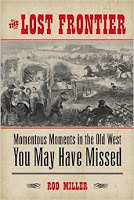
According to recent news reports, archeologists from the state of Idaho and Utah State University have pinpointed the site of the 1863 massacre at Bear River. Which is not really big news, as the site has always been known, if not down to the square inch, by Shoshoni descendants and historians.But farming, floods, railroad and road building, and a shifting river course have altered the terrain beyond recognition of its appearance in 1863. A map by a soldier—whose account also cemented the fact that it was a massacre rather than a battle as official army accounts claimed—helped in locating the Shoshoni village site, along with “modern technology.”The massacre at Bear River was the first massacre of Indians by the military in the Old West, as well as the worst, with a body count surpassing Wounded Knee and Sand Creek and other better-known tragedies. While 400 to 500 Shoshoni deaths are often reported nowadays, those numbers are inflated and based on accounts with little credibility. Still, the more realistic number of 250 to 350 Shoshoni deaths at soldiers’ hands remains unsurpassed in Old West history. Still, it is largely forgotten. Few people—even historians—know much, if anything, about the massacre. And that’s unfortunate. You can learn more about it in a chapter of my book The Lost Frontier: Momentous Moments in the Old West You May Have Missed , and in greater detail in my book Massacre at Bear River: First, Worst, Forgotten .
Published on June 12, 2016 09:52
June 4, 2016
Brenn Hill makes more music.
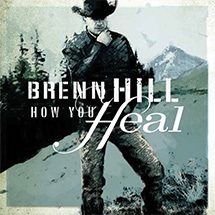
Anyone who’s been paying attention knows I am a fan of Brenn Hill. As songwriters go, he’s one of the best in the West. And he’s a talented singer and skilled musician. I first heard Brenn’s music back in the late ’90s at a festival in Cache Valley. I don’t think he was shaving with any regularity back then, but his lyrics already surpassed the standard cowboy clichés to reveal facets of our Western world we all recognize but see with fresh eyes through his songs.His debut Rangefire album has been in my collection since way back then, and it has spent more than its share of time in a succession of CD players over the years. Several years and a dozen or so outstanding albums later comes How You Heal. Sixteen songs, all Brenn Hill compositions, range from celebrations of cowboy work and Western places to songs that seem inspired by the writer’s maturity into his middle years. “Middle Age Cowboy,” a story of a cowboy who clings to the life despite pressures to relent, will be familiar to all who reluctantly moved on to other pursuits. “Twenty and Cowboy” is a wistful reflection of years gone by. My favorite track just might be “Fair Weather Cowboy,” a rollicking revelation of a reality many experience but few will admit. The other songs on the album are remarkable for reasons of their own. If you’re a Brenn Hill fan, you’ll like adding How You Heal to your collection. If you’re not, you ought to be.
Published on June 04, 2016 05:58
May 26, 2016
The cat is out of the bag. Sort of.
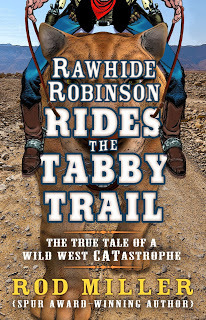
Western Fictioneers, an organization of authors who write novels and short stories about the Old West, recently announced nominees for their annual Peacemaker Awards. The awards, named in honor of the Colt revolver, are bestowed upon the Best Novel, Best Short Fiction, Best First Novel, and Best Novel for Young Adults or Children. I’m happy to say that Rawhide Robinson Rides the Tabby Trail: The True Tale of a Wild West CATastrophe, is nominated in the latter category. Winners will be announced June 15 and if there is further good news I will pass it along.This recognition, along with being named a Western Writers of America Spur Award Finalist, is high praise for my latest novel. If you haven’t read Rawhide Robinson Rides the Tabby Trail, you can order a copy through your local bookstore or online, both in hardcover and e-book. There’s a short video about the book on my Amazon Author Page and out there elsewhere. Whether young or old—say from junior high school student to senior citizen—you’ll get a grin out of the extraordinary exploits of an ordinary cowboy.
Published on May 26, 2016 05:39
May 21, 2016
Lies They Tell Writers, Part 28: Writing is a Lonely Life.
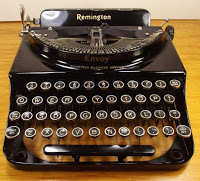
You’ll often hear it said that writing is lonely. It takes hours, days, weeks, months, years spent alone at the keyboard (or typewriter or notebook) to spin a story, write a novel, sort out history, create a poem, construct a magazine article, or whatever it is you write or intend to write.Which is true, sort of. But I would use a different word to describe writing time: solitary.That’s because while I am usually alone when I write, I don’t find writing lonely. I spend that time conversing with characters, getting inside their heads, reading their thoughts, understanding what makes them tick, waiting to see what they’ll do next. That’s a lot of what makes writing fiction fun.Even when writing nonfiction—a magazine article, or history—it usually comes down to living with people in your mind and attempting to understand why they do what they do or did what they did and how that fits into the big picture. Poetry, too, requires immersing yourself in a world of words, of sounds, of rhythms, of ideas, of images. Which is anything but lonely. In fact, it can get right crowded and noisy in there. Finally, if you want to know the truth, sometimes—oftentimes—the “loneliness” of spending time in those other worlds is more enjoyable than living in the real world.
Published on May 21, 2016 06:05
May 14, 2016
Bye-Bye Byline: Ranch & Reata, for the last time.
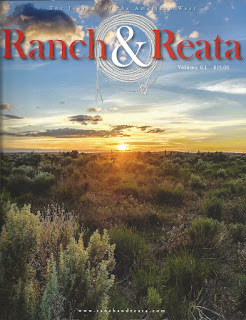
The new issue of Ranch & Reata is out. Unfortunately, it’s the last of what has been an outstanding publication. For more than five years, the magazine has covered a lot of interesting people and places from all around the West. I know, because I had the opportunity to write about many of them.While I didn’t have a byline in every issue, it was pretty close—and, in a few, I had two stories. That’s the case with this final issue.“The Top hand and the Tenderfoot” compares the experiences of two poets at the 2016 National Cowboy Poetry Gathering—Wally McRae, who has been there since the beginning more than three decades ago, and Marleen Bussma, who made her first appearance this year. It’s an interesting look at what has become a fixture in the world of Western culture, seen through the eyes of a pair of participants.Also in the magazine is “Ninety Percent Off,” a story about War Paint, the legendary saddle bronc horse of the ’50s and ’60s who bucked off about nine out of ten of all the rodeo cowboys who stretched a cinch around his middle. Among his victims were the best bronc riders in the business, including world champions. The article was inspired by and quotes Idaho cowboy Bob Schild, who got on—and off—War Paint twice in his career. I’m sorry to see Ranch & Reata go. It has been a real pleasure to pen stories for them.
Published on May 14, 2016 17:32



